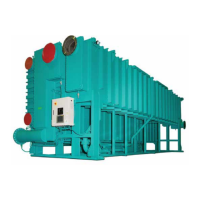JOHNSON CONTROLS
19
SECTION 2 – PRODUCT DESCRIPTION
FORM 155.30-ICOM2.EN.UL
ISSUE DATE: 12/21/2018
2
Since the solution temperature in the generator is nor-
mally high enough that no crystallization will occur as
long as the higher temperature is maintained. Before
the unit is shut down, make sure the solution is suffi-
ciently diluted in all areas of the unit to prevent crystal-
lization during the off cycle. Remember, the solution
temperature will eventually become equal to the ambi-
ent temperature of the room.
To prevent crystallization all units employ a dilution
cycle. As long as the unit is allowed to dilute itself dur-
ing an orderly shutdown sequence, the unit should be
able to sit idle at fairly low plant room ambient temper-
atures without any threat of crystallization. Typically,
after a dilution cycle, the average solution concentra-
tion within the chiller will be below 45% lithium bro-
mide by weight. Although the crystallization line on
Figure 64 on page 152 does not extend that far, you
can see that the solution at 45% concentration will not
have a tendency to crystallize at normal ambient tem-
peratures.
WHY DOES CRYSTALLIZATION OCCUR?
The most common reason for crystallization is power
failure. If a chiller is running at full load and power is
interrupted for a sufficient length of time, the concen-
trated solution in the high side of the unit will eventu-
ally cool down. Since no dilution cycle was performed,
the solution concentration in some areas of the unit will
still be high. If the temperature of this concentrated so-
lution is allowed to fall enough, the solution will reach
its crystallization point. Plant room temperature, insu-
lation quality and the solution concentration determine
how long it will take before the unit will crystallize.
See SECTION 7 – MAINTENANCE for information on
water quality control and crystallization. The Duhring
Diagram / PTX Chart shows the specific temperatures
and pressures of the crystallization area. See Figure 64
on page 152 and Figure 64 on page 152.

